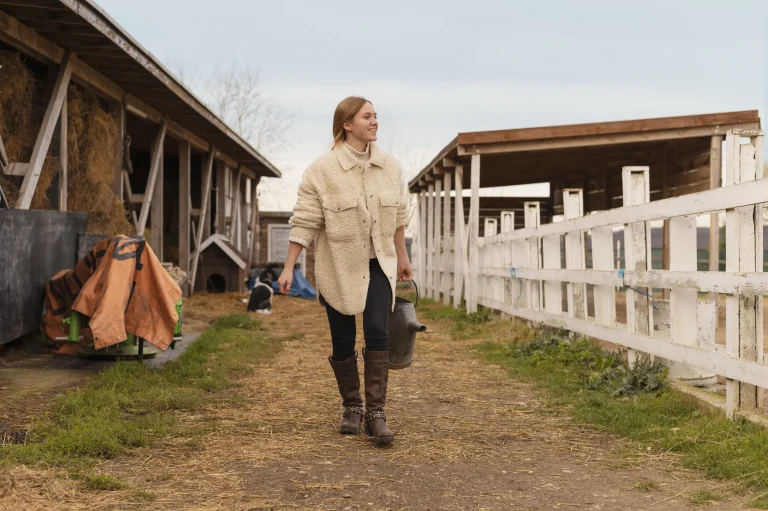Homesteading often brings to mind images of wide-open land, expensive equipment, and big budgets. But what if you don’t have any money to get started? The truth is, you don’t need a lot of cash to begin living a more self-sufficient lifestyle. With creativity, resourcefulness, and determination, you can start your journey toward homesteading without spending a dime. This guide offers ten practical ways to homestead with no money—perfect for beginners looking to embrace a simpler, more sustainable way of life.

What Does It Mean to Homestead With No Money?
When you choose to homestead with no money, you’re choosing to build a life based on self-reliance, reuse, and skill-building instead of consumption. You’re shifting away from the belief that progress comes from buying more. Instead, you’re embracing a lifestyle where value is created by what you grow, make, barter, or repurpose.

By changing how you look at resources, you’ll find opportunities everywhere—whether it’s a broken pallet turned into a raised bed or a pile of vegetable scraps saved for seed.
1. Start With What You Have
Before looking outside for solutions, look around your home, garage, and backyard. Chances are, you already have the tools to begin.
Ideas to Get Started:
- Use old containers (buckets, bins, milk jugs) as planters
- Repurpose scrap wood into trellises or garden boxes
- Use kitchen scraps to begin composting or seed-saving
- Repurpose an old shelf as a growing station
You don’t need to buy tools or supplies—you just need to rethink how you use what’s already around you.
2. Barter and Trade for Supplies
Bartering is a powerful tool in a no-money homestead. Instead of buying what you need, offer your time, skills, or homemade goods in exchange.
What You Can Offer:
- Yard work, babysitting, or pet sitting
- Handmade soap, bread, or crafts
- Skills like tutoring, sewing, or basic repairs
What to Ask For:
- Seeds or seedlings
- Gardening tools
- Extra canning jars or kitchen equipment
Join local Facebook groups, attend community events, or simply ask neighbors—people are often willing to trade if it helps both parties.
3. Use Free Online and Community Resources
There’s a wealth of free knowledge and supplies available if you know where to look.
Where to Find Help:
- Libraries: Free books and classes on gardening, preserving, and more
- Extension offices: Free soil testing, farming advice, and gardening guides
- Online videos: Channels focused on frugal homesteading or DIY projects
- Community centers: Skill-sharing events, seed exchanges, or workshops
Don’t underestimate the power of asking for help—local communities love supporting beginners.
4. Forage and Wildcraft Sustainably
Nature provides more than you realize, and learning to forage is a powerful no-cost homesteading skill.
What You Can Forage:
- Dandelion leaves (salads, teas)
- Wild garlic and onions
- Mulberries, elderberries, and wild herbs
Wildcrafting Ideas:
- Collect pine resin for homemade salves
- Use stinging nettle for tea and compost boost
- Gather fallen branches for firewood or crafting
Always forage responsibly—never overharvest and be 100% sure about plant identification.
5. Build a No-Cost Compost System
Composting transforms your waste into rich, fertile soil—and it costs nothing.
🌿 Want to build a productive garden and reduce waste at the same time?
👉 Learn how to transform your backyard with The Self-Sufficient Backyard — it’s packed with no-money techniques like composting, water harvesting, and seed-saving to help you thrive on what you already have.
How to Build a Free Compost Setup:
- Use pallets, trash cans, or chicken wire to create bins
- Add green waste (veggie peels, coffee grounds) and brown waste (leaves, shredded paper)
- Turn the pile weekly with a stick or shovel
Over time, you’ll create free fertilizer that supports a thriving garden.
6. Start Seeds From Scraps and Save Seeds
Seeds don’t have to cost a penny. You can grow many plants from kitchen scraps and save seeds from produce.
Grow From Scraps:
- Regrow lettuce, celery, or green onions in water
- Sprout garlic cloves or sweet potatoes
- Plant potato eyes in soil
Save Seeds From:
- Tomatoes, peppers, and squash
- Dry beans or peas
- Sunflowers and herbs
Once you learn seed-saving, you’ll never need to buy them again.
7. Upcycle Materials for Homestead Projects
Instead of buying materials, start collecting items people throw away or give away for free.
Great Freebies to Look For:
- Wood Pallets: Turn into garden beds, tool sheds, or compost bins
- Old Windows: Use for cold frames or small greenhouses
- Bricks and Rocks: For garden borders or fire pits
- Clothing and Fabrics: Make reusable bags, rags, or quilts
Sites like Freecycle, Craigslist, or local Facebook groups are full of opportunities.
8. Harvest Rainwater for Free Irrigation
Watering your garden can drive up utility bills. Rainwater is a free, sustainable solution.
How to Start:
- Use buckets or barrels under gutters
- Add a screen to keep out debris and bugs
- Store in shaded areas to prevent algae
Rainwater collection is legal in most areas, but check your local rules first.
9. Cook From Scratch Using Basic Staples
Buying pre-made food adds up fast. Cooking from scratch using staples you grow or trade for keeps costs down and health up.
No-Money Pantry Meal Ideas:
- Flatbread: Mix flour, salt, and water
- Vegetable soup: Use foraged greens, potatoes, onions
- Homemade tea: Brew dried mint, nettle, or chamomile
- Bean stew: Use dried beans, garlic, and herbs
Cooking is a foundational homesteading skill that brings value to every part of your home.
10. Join or Create a Homesteading Community
You don’t need to homestead alone. Being part of a local community makes everything easier.
Ways to Connect:
- Start a Facebook group for local bartering or seed swapping
- Volunteer at a local farm or garden co-op
- Attend homesteading meetups or classes
- Organize a free skill-share event
Your community can offer tools, mentorship, inspiration, and friendship—all without money.
🛠️ Recommended Resource: The Self-Sufficient Backyard
If you’re serious about building a homestead from scratch, The Self-Sufficient Backyard is the ultimate guide to doing more with less. Written by a couple living entirely off-grid, this book teaches you how to grow your own food, harvest rainwater, build with free materials, and preserve your harvest—all without relying on expensive systems or tools.
Inside, you’ll learn:
-
How to raise chickens and grow food on a shoestring budget
-
Easy DIY hacks for food storage and composting
-
Strategies for reducing your dependence on modern infrastructure
✅ Click here to get The Self-Sufficient Backyard and start your no-cost homestead journey today.
Tips for Success When You Homestead With No Money
- Focus on skills, not stuff. Learn how to make or fix things.
- Embrace reuse. Trash to one person is treasure to a homesteader.
- Be patient. Growth takes time—celebrate small wins.
- Keep learning. Watch tutorials, read books, and ask questions.
- Document your journey. A notebook helps track progress and motivates you.
FAQ: Homestead With No Money
Can I really homestead with no money?
Absolutely. Homesteading is more about creativity, community, and determination than finances. You can begin with zero dollars and still make meaningful progress.
What should I do first if I want to homestead with no money?
Start with what you already have. Begin composting, save seeds, or grow herbs in recycled containers.
Do I need land to homestead?
Not necessarily. Many people start homesteading on patios, balconies, or community garden plots.
How do I find free supplies or materials?
Use websites like Freecycle, Craigslist, Buy Nothing groups, or community boards. Don’t be afraid to ask neighbors or friends.
Is homesteading without money sustainable long-term?
Yes—if you focus on building skills, connecting with others, and making thoughtful choices. Over time, your savings and productivity will grow.
Final Thoughts: You Can Homestead Without Spending a Dime
Homesteading with no money isn’t about being cheap—it’s about being resourceful. It’s about taking control of your food, health, and future without waiting for the perfect time or budget. You don’t need land, money, or fancy tools to start. You need commitment, curiosity, and a willingness to do things differently.
Take one idea from this list and try it today. Grow herbs on your windowsill. Ask your neighbor about extra jars. Save seeds from tonight’s dinner. Every step you take brings you closer to your goal.
Share your journey with others. Post your progress, ask for help, and inspire someone else to begin. The homestead life is possible—no wallet required.
🌾 Ready to take the next step?
Start with the guidance in The Self-Sufficient Backyard and learn how to turn simple resources into a thriving homestead—even if you’re starting with nothing.

